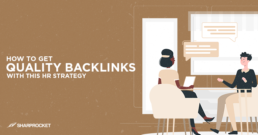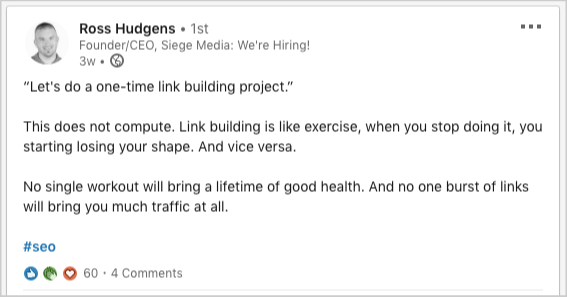How to Turn Your Blog Into A Link Building Machine (Untapped Blog Linking Opportunities)
TRANSCRIPT
In this episode, you’ll discover untapped backlink opportunities for your blog that you often missed out on as you publish new content pieces regularly.
At the end of this episode, you get to practice different ways to market your blog content without the crazy stress of hiring more content marketers or even without spending excessive time brainstorming for strategies. I’ll give you the exact strategies on how to turn your blog into a highly linkable machine.
Blogging is a great way to start pushing out content that serves a targeted audience.
But blogging alone, like what other brands and publishers do, won’t get or earn you links.
Competition does this. And what you need is to stand out in the market, to be able to earn attention, visibility where people could actually cite your work for their content.
The strategy in blogging for links should be refined over time.
However, there are fundamentals you can start right now to turn your blog into a link building machine.
Table of Contents
Let’s get started.
The first is to:
Invest in evergreen content assets
Timely, trending content pieces help build initial attraction, as it speaks for the latest happenings in the industry.
But if you’re seeking long-term traction that gets publishers’ attention plus organic links, you invest in evergreen content.
And by evergreen, this means that the information could be used time and time again. It only needs some tweaks and updates every year to serve its content consumers with more relevant information.
The key for brand blogging is to balance the two: evergreen and timely content pieces.
One recommended tip here is to have a page with its URL that’s not year-dependent, meaning if you’re into fitness, you don’t create a page with its URL, “fitness tips 2021”.
When next year comes, you have to change the URL again; one thing you can do is to have the URL settled for just: fitness-tips or fitness-tips-this-year
When you build these evergreen content assets, you want to invest heavily in content promotion. If you have a limited budget, you prospect for authors in your space who could potentially distribute your piece or put more eyeballs to the page by linking to it from their own webpages.
I’ve seen so many 10x content assets that often missed out its potential, given they’re not promoted much.
This is what we call the content flywheel.
When you publish a solid content asset that serves a likable audience, you build links to it; then, it attracts more from other publishers as it gets ranked for specific keywords and/or from other channels.
You build another one and get links again for that content piece. Then as you build momentum, you get to see this content flywheel -- where every content asset you publish has an audience ready to promote it socially.
What you want here is to capture these audiences quickly, so as soon as you publish content, you have an audience ready to promote your content.
Though we’re talking about link building, one of the most important pieces in content marketing is investing in lead magnets to turn your visitors into email subscribers.
These email subscribers, indirectly, can help your content get more visibility, which can later translate into more linking opportunities for your blog.
To turn your blog into link building, invest in evergreen content assets and experience a content flywheel yourself.
Next is to have:
Implement a linkbait strategy for your blog
For brands who have established authority in the space, it’s easy to set this up, as they have existing readers and eyeballs to put this strategy in place.
But you can have a linkbait strategy even if you’re starting.
One way to do that is to invite authors to write for your blog. These authors aren’t just content creators for hire; you want to go after people who have contributed content to other publications in your industry.
They may, at some point, have an existing audience you can capture for your brand.
What you need when you craft your outreach email is to establish the answer to the question, “what’s in it for me?”.
This is crucial because these authors won’t take the time to write content for your blog without them benefiting from it. So start by asking yourself this question.
As a brand, what is something you can offer for authors in exchange for their quality content?
I remember writing for several SaAs blogs in the internet marketing space. I get premium access to one of their tools for 6 months or 1 year in exchange for writing quality content for them.
If the author has a business ongoing, it’s a no-brainer not to want those free stuff -- which could be considered as an investment on their part.
So I want you to look for available resources as a brand. What is that something that you can offer to your potential blog authors in exchange for their content? Of course, the higher the perks are, the higher demand of quality you should be receiving in terms of content.
Can you offer 6 months or a year premium access to one of your tools or services? A mastermind or exclusive VIP access where they can collaborate and learn from top-notch experts in your industry?
Start a linkbait strategy for your blog and see results for yourself.
And one of the effective strategies that I’ve seen with local brands today is this:
Create an awards type of content
This strategy has been overused before by marketers, but I’ve still seen this technique heavily used by brands today -- effective only if they do it the right way. 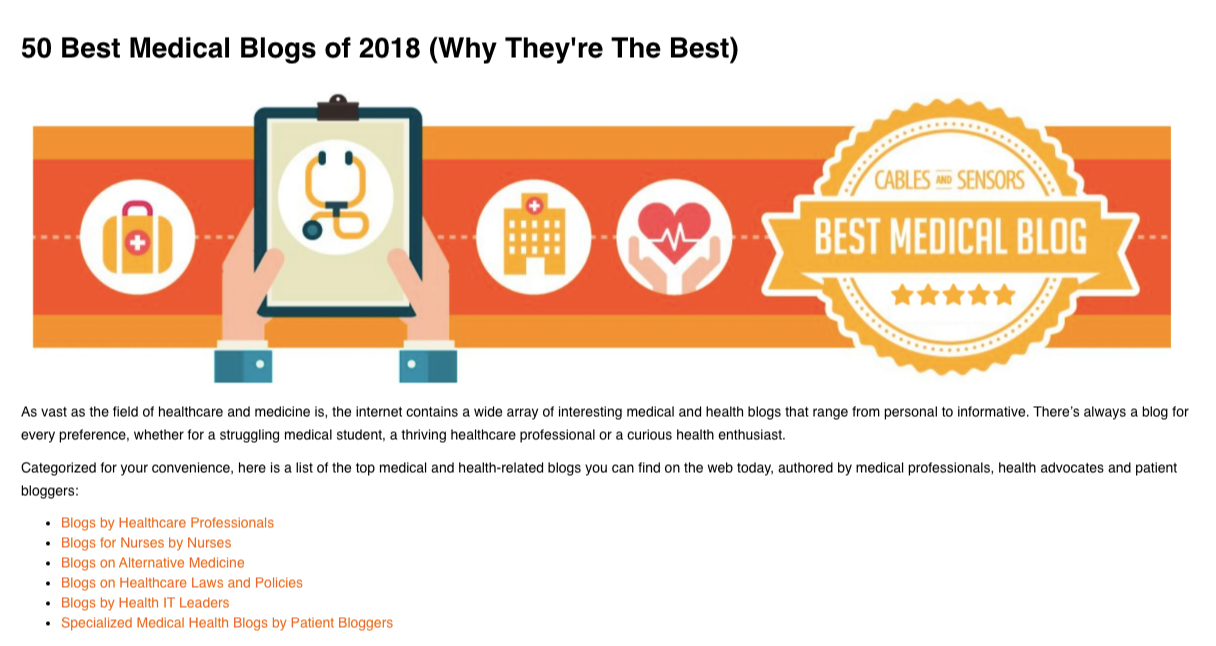
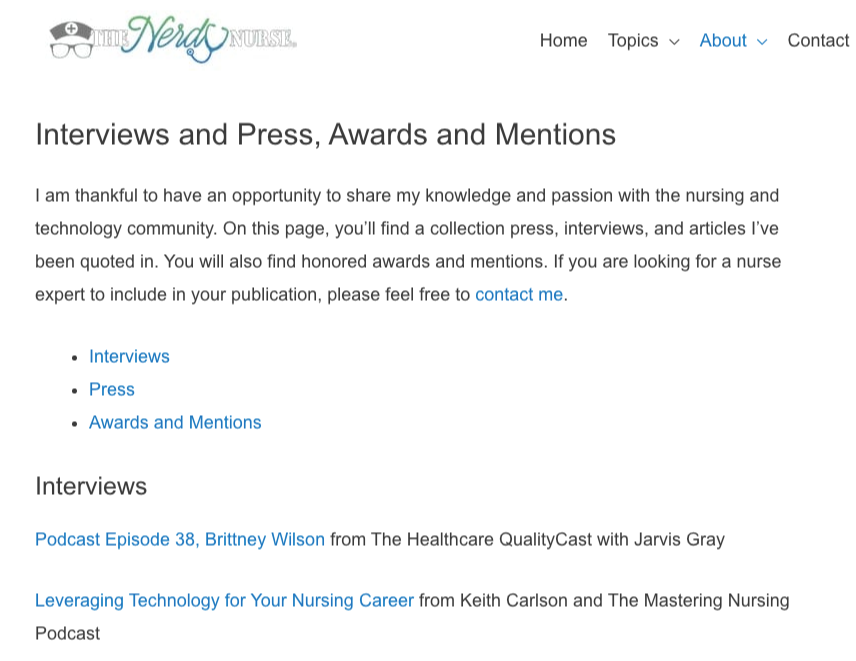
The award concept basically lists down the top publications/brands in your space based on specific criteria.
Now, as you are listening, you feel that it would incur many expenses to do that.
But the fact is when most brands did this is in a simplistic form. They rank the “best” or top X blogs, make the page so attractive that it gets the attention it deserves.
This would help your blog turn into a link building machine is. Once you publish the page, you can reach out to all of the brands, content creators, or target groups you mentioned on your page.
It is best to award people who already have some online presence, as you can capture what they currently have in terms of following your own brand.
So when you send them emails that they become part of this top X page, they could either link to it from their “about” or “press’ page. It’s like a straightforward brag to show people their credibility and added authority in the space.
Having a badge for these people you can customize is a game-changer as this would be value-adding to them as a brand.
So have that in place as one of your strategies to get organic links.
(podcast final script)
So there you go, you discovered ways to turn your blog into a link building machine.
Before you go, I have a special gift for you. If you’re looking for ways to build backlinks to your online store or you’re stuck as to what link building strategy to use for your website, go to the description of this podcast episode.
Go to either of the two resources I shared there. One resource is a blueprint that my team and I have used to scale ink building for clients and another resource for link building opportunities in the eCommerce space. Go and grab those resources so that you won’t have to worry about how to do link building for your website.
For more link building and content marketing tips, be sure to subscribe to this podcast to notify the latest episodes. Just click the “Follow” button. See you in our next episode.
The Truth About Passive Link Building (REVEALED: What Marketers Don't Understand?)
TRANSCRIPT:
The truth about passive link building
In this episode, we’ll look at when passive link building is a good idea, and when it is not. Marketers don’t understand what it really means to have passive links, as they’ve been reading a lot of SEO articles in the past and don’t have much clear understanding of the term.
At the end of this episode, you’ll get one takeaway that will change your mindset when it comes to link building.
Table of Contents
Passive link building.
The ability to position your brand as an authority in the space to earn market share through link earning - getting people to link to you from their websites.
That’s the basic definition of passive link building.
Passive link building happens when:
A content creator - whether a blogger or a publisher cites you in one of his or her content works, meaning he or she founds value in your content and could consider being a good reference for his or her readers.
Passive link building happens when your product or service is so good that it gets the attention of content creators creating a round-up post for the best [service or product]. You don’t have to reach out to be included, though if you’re still on the list, you can, typically you get part of the list without manual outreach.
When people search for a keyword, they found your page on one of the top pages of search results, bookmark your content, get a quote/statement from your content asset, make it part of their content and give you a credit for that.
What marketers don’t understand is that passive link building doesn’t happen instantly without any active initiatives.
Here’s why…
Building a brand requires intentionality
To get to the point where people would recognize you and make you as a reference to their content is simple, but not that easy.
It would take a lot of effort to get to the point where your brand, product, or service gets noticed in your content, especially in this day and age where most businesses are invested in content marketing.
The competition is high, but the visibility for content and brand is very promising.
Here are more truths about passive link building:
“Build it and they will come” is a myth.
For the most part, when you are building a solid portfolio of content assets on your website, you’re likely to end up creating new content pieces on a regular basis.
For each content asset, there may be an existing audience ready to promote it - such as your email subscribers or your social followers.
But if you’re thinking of growth, you want new people to see it -- a new set of eyeballs.
People have to see it so you build the content and promote it with your best efforts. After conducted hundreds of outreach campaigns, the idea of “build it and they will come” is not a sustainable idea.
So instead of waiting for links to come like what most marketers think when passive link building comes to mind, why not ask for links.
Ask for links from target publishers you’ve mentioned on your content asset, from people whom you think will be interested to distribute your content, and from those people who have the capacity of linking - editors, resource link curators, webmasters.
The second truth about passive link building.
Competitors are ahead of the curve in actively building backlinks
As a link building agency working with enterprise brands. We’ve seen a dramatic increase in the amount spent by these big companies.
And take note they’re not just hiring one link building vendor, meaning one agency to work towards their link building campaigns, but have 2 or 3 different link building vendors performing simultaneous link building strategies to build a high-level number of links.
If you stay with the mindset of “build links, they will come”, you will be left behind in the competition.
Businesses, even local ones are now investing in link building to get to the top spots of search results for their target keywords.
Yes, links aren’t the only ranking factor, but it is the main ranking factor.
So if you’re not actively promoting your content through link building, there would come a time when your competitors will beat you up with their active link building campaigns.
Passive link building isn’t controllable
You can’t control the time when would a link builder will link to you, whether it is active or passive. You cannot also control how they would want to link to you.
With passive link building, you’ve got the brand and you can reach out to whenever possible for some changes in anchor text and the type of page they should be looking at. So for example, instead of them linking to your homepage, it is best for them to link to your product category page, as it is more direct to their target readers on a specific editorial context on their page.
With manual active link building, as you are into the conversations with potential linkers, you can persuade them the proper anchor text that you want, may not always be an exact match to your keywords, but a mix of brand, partial and referential keywords.
You can check my other episode on 9 types of anchor texts to discover more about these anchor texts.
Anything that isn’t controllable is hard to measure in the long run, you would want to create systems to get consistent results with your efforts.
Passive link building is good, but you have to consider different factors to get there.
Push more of your content assets in the proper way of manual outreach and engaging in your online communities.
Seek more promotion from your team. Get into the habit of actively building backlinks to pages that you want to rank, so you can sustain more performance from organic search.
So there you go, you have discovered 3 truths we revealed about passive link building, that marketers don’t understand so well.
Before you go, I have a special gift for you. if you want done-for-you email templates, simply go to the description of this podcast episode. Go to the link that I shared there. These are email templates for link building strategies that you can easily copy and paste and get results for your outreach campaign.
For more link building and content marketing tips, be sure to subscribe to this podcast to get notified of the latest episodes. Just click the “Follow” button. See you in our next episode.
Why You’re Not Getting Backlinks and How to Change That
Table of Contents
The first reason why you’re not getting backlinks is that:
Your homepage and content are not linkable for the right audience
Here’s what it means.
When it comes to link building, one of the things that are important is making sure parts of your website are linkable.
I say “parts” because, in reality, not all pages of your website are linkable. Some are designed to specifically get leads, earn sales, and therefore they are not purposefully for links, but rather for conversions.
Though some, if matches to the right linkable audience, and has parts that are linkable, can still be of use for link building.
But in general, there are pages of your website that are likely to get backlinks, because it serves the purposes for links -- to get referenced by the author or publisher, to be mentioned because of the value and expertise of the brand.
The key action here is to check parts of your website -- the ones you’re actively promoting to different platforms, and see if they are really linkable.
One question you can ask yourself is: If I were the linker, and when I see this content that I’m promoting, would I link to it from my website?
The second reason why you’re not getting backlinks is that:
You are targeting a different audience
The utility of the content -- how useful it is to an audience is very subjective. A content asset can be useful for one audience, but not for the other types of audience.
Bloggers, publishers, content creators, journalists are the ones likely to give you backlinks.
People in your networks who are competing with you -- as you both have similar products or services won’t dare to give you links unless you have content worth referencing.
I want you to check out my other episode on a linkable audience - to help you discover the audiences that can give you backlinks, and be able to match your content to them so that you can acquire links to your website.
Another thing that you want to do is to check other audiences you haven’t reached out to yet in the past.
The thing is if you’re in a very specific niche, there are less likely bloggers and publishers ready to give you backlinks.
So let’s say you’re in the local plumbing niche, you wouldn’t see many plumbing blogs sharing much content targeted in a local city.
You would either:
- Find other industries where you can find audiences match to you, or:
- Find other local city blogs (not specific to your industry), but are targeting the same audience in terms of location.
By doing so, you expand your reach to a wider scale, and not just targeting people you already know.
The third reason why you’re not getting backlinks to your website is:
You haven’t done much promotion (or manual outreach)
Some marketers fail in getting backlinks they need not because they have crappy content assets, but they simply were not able to promote their content massively to their audience.
Here’s the thing when it comes to promotion: if you really believe in your content asset, just like how you believe your products/services, you will dare to promote it.
There are many ways to promote your content, and I’ve covered a bunch of that in my other podcast episodes.
But to start with.
Can you check your current networks, partners, and see if they have their own websites or blogs? You don’t have to start from scratch when it comes to link prospecting, you go look for anyone you already have connections with, and start touching base on them?
Also, can you look for different platforms in Google, Facebook, Linkedin groups (without using expensive tools) for any possible link prospects -- bloggers, publishers, content creators, journalists who can cover and promote your content?
What is the value of your content? How can you emphasize the value of your content so that when it is pitched, it is an offer publisher can’t resist linking to it.
You haven’t done much promotion (or manual outreach)
-- prospected for tens, but not enough to get links in manual outreach.
5 Critical Skills to Look For When Hiring a Link Builder (Save Money By Knowing This!)
Table of Contents
The first skill when it comes to hiring a link builder is:
Communication
The task of a link builder involves writing email outreach copies, which would of course require having the skill to communicate effectively with your prospects.
Initially, you want to see if a potential hire is able to write an email copy based on certain customization, like promoting a single content piece to a target group of an audience - let’s say, journalists.
In Digital PR, it’s extremely important to have the initial email pitch concise as much as possible, and get straight to the point as to what you really want to offer to a publisher -- whether you want to offer the content exclusively published to them or just want the website to be one of the distribution networks.
A good test when hiring a link builder is to let them write their own email template, assigning an audience they’d reach out to with a specific need of your client/brand -- promoting a single content asset, collaborating for a partnership, or sending discount coupons to bloggers.
A link builder with good communication skills can easily describe a content piece to be promoted, and can effectively engage with link prospects to get the desired action -- links, shares, or other brand exposure.
Organization Skills
The ability to organize one’s thoughts plus being able to arrange details of a link prospect necessary when you do email outreach.
A link builder with organization skills is to arrange inputs about a specific website either in a spreadsheet or outreach platform like Buzzstream.
This is important, as you don’t want your team to waste so much time going back and forth looking for a detail (let’s say contact info) of a link prospect, just because someone wasn’t able to input it well on an outreach platform.
Organization skills can also translate to how a link builder organizes content topics either to be used internally or externally (for other websites’ blogs).
If you’re working in an agency, this means that a link builder knows how to collect all files and put them in one place, i.e. Google Drive, so when anyone in the team wants to access it, they are easily available and ready to edit and distribute.
This may sound pretty basic, but it’s one of the main reasons why link building teams spend hours on minor tasks than on major tasks like creating content and pursuing publishers for links.
So look for someone who has organizational skills.
Creativity
Creativity is a skill that a link builder must possess to perform at the highest level in link building.
If you’re taking content creation into the highest consideration, your potential hire must think outside the box, of what makes content enticing to publishers, and not just data-driven.
Content marketers from content marketing agencies like Fractl, Siegemedia, and Neomam have proven to have creativity in the way they produce infographics, interactive content, and other types of content that garner links for their clients.
When a link builder is creative, he or she can also think of ways on how to promote a content piece beyond just posting on targeted online communities and forums. With creative email pitches, a creative link builder can secure links from top-tier publishers and bloggers their competitors can’t easily get.
Problem-solving
Like any other campaign, link building entails challenges.
So a potential hire must have problem-solving skills to be able to spot problems and issues quickly, and get them solved either by themselves alone or with the help of people they’re working within the team.
In prospecting, you’re likely to experience that what you have just targeted as a team to look for websites won’t respond to your email outreach later, given its relevance and signs that websites are not easy to just get links from.
Look for a potential link builder with good problem-solving skills to be able to come up with solutions, which may not be quick, but just at the right time, to address issues and concerns either directly about the campaign itself or about issues with the team.
And one of the most important critical skills you should be looking for when hiring a link builder:
Leadership (self and team player)
You may not hire urgently for a managerial role, but one you should be looking for must present leadership skills in how he/she deals with himself or herself, and you think he/she can collaborate with your team effectively.
Culture is important before you begin hiring. When you have a strong culture in your team, either in your in-house SEO team or agency, you’ll guarantee people would come to you that either joins or matches your team culture or would simply just leave because they possess different values.
How to Ethically Steal Your Competitors' Backlinks
Table of Contents
Why competitors backlinks?
First off, we have to understand the reason why links from competitors are good types of links.
Let me give you two main reasons.
First is that these competitors' backlinks are niche relevant.
So if you’re an absolutely beginner, you want to be looking for websites that are topically relevant to your brand.
And given that those publishers and bloggers linked to your competitors, and you directly compete with your competitors, chances are what you’ll be getting from your competitors are directly connected to your blog topics.
Relevance is a critical success quality factor in backlinks. And this is something you should always consider when you try to build backlinks to your website.
Second, not only that these competitor backlinks are niche relevant. But they are also easy to prospect.
When you are prospecting for backlink opportunities, you’re likely to be using Google with advanced search operators and phrases to help you find pages on the search results that best suits your prospecting needs.
But in the case of reverse engineering your competitors’ links, you only have to use a simple tool to find all pages that linked to your competitors.
So let’s jump into how you can get your competitors' backlinks.
How to Ethically Steal Your Competitors' Backlinks
There are three steps that you can choose from based on where you’re at right now.
Find your competitors' top linkers.
The top linkers are not the ones who linked to a website once. They are the linkers who repeatedly link to pages of websites because they found value in those content.
So how can you find these top linkers who constantly link to your competitors?
Get the domain of your competitor’s website. Plug it into Ahrefs’ Link Explorer.
We’ll use Tuck, a sleep product review website as our example.
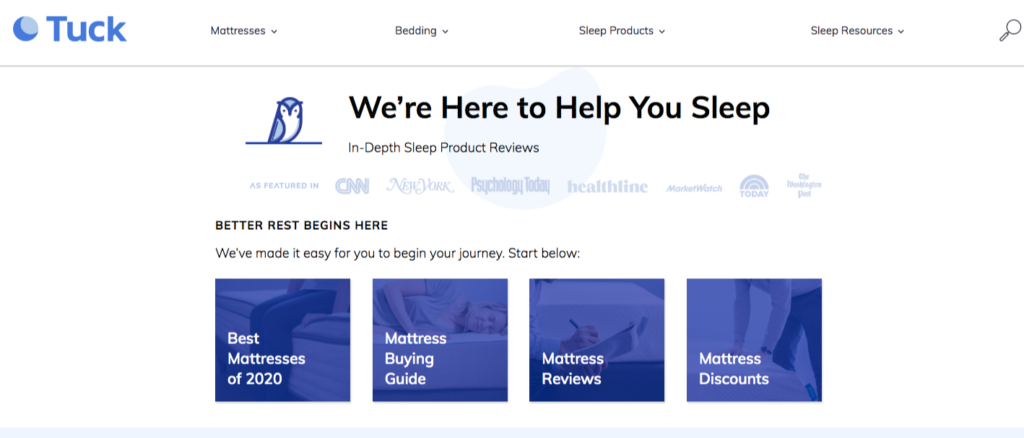

I’ll get tuck.com and plug it into Ahrefs’ Link Explorer. On the Backlinks area, right at the Backlink Profile section, I’ll be able to see all the websites that linked to tuck.com
As of this recording, there are 9,620 unique websites linking to Tuck.


That’s a lot!
So out of these 9 thousand plus linking websites, how can you find the quality prospect websites you should be looking for.
And not only that, how can you find those top linkers who repeatedly link to the Tuck website.
Here’s a strategy that you can follow.
Get all of the top 10 to 20 pages of your competitor.
On Ahrefs, you can see it either on the Top Pages section or Best by Links section.
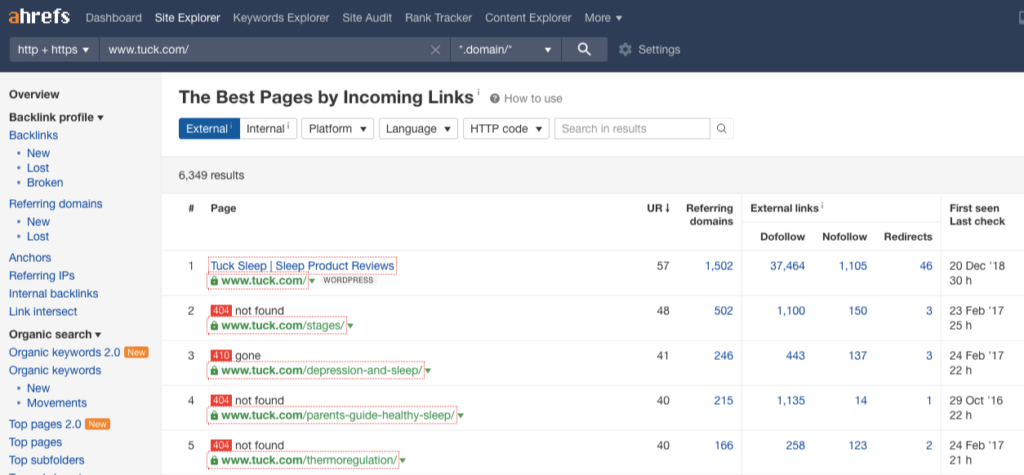

The next thing you want to do is to use Link Intersect to see the websites to at least two of the top pages of your competitor.
So first is to insert all top pages in Link Intersect one by one.
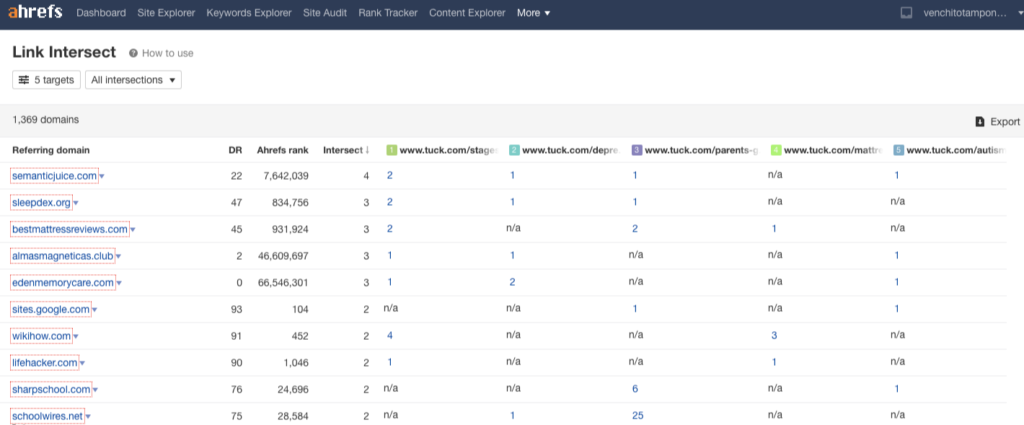

Then click “All Intersections” on the top section and only check 3 targets.
This would give you websites that linked to your competitor at least 3 times.
So these are your competitors’ top repeated linkers.
You do the exact steps I shared earlier to your other competitors, to also see their top linking websites.
Find your competitors' linkable content.
Any page that earns hundreds of backlinks or that have the potential to acquire more links can be considered as a linkable content.
Chances are your competitors have linkable content in place. You just have to know what those pages are.
For this specific activity, you can use Ahrefs to find linkable pages of your competitors.
Insert the domain URL of your competitor’s website to Ahrefs’ Link Explorer.
Then go to Best by Links.
Here, you’ll see the Best Pages by Incoming Links.
You can sort these pages from highest to lowest referring domains to see the highest linkable content.
By checking each of the page, you’ll see what types of content gets links.
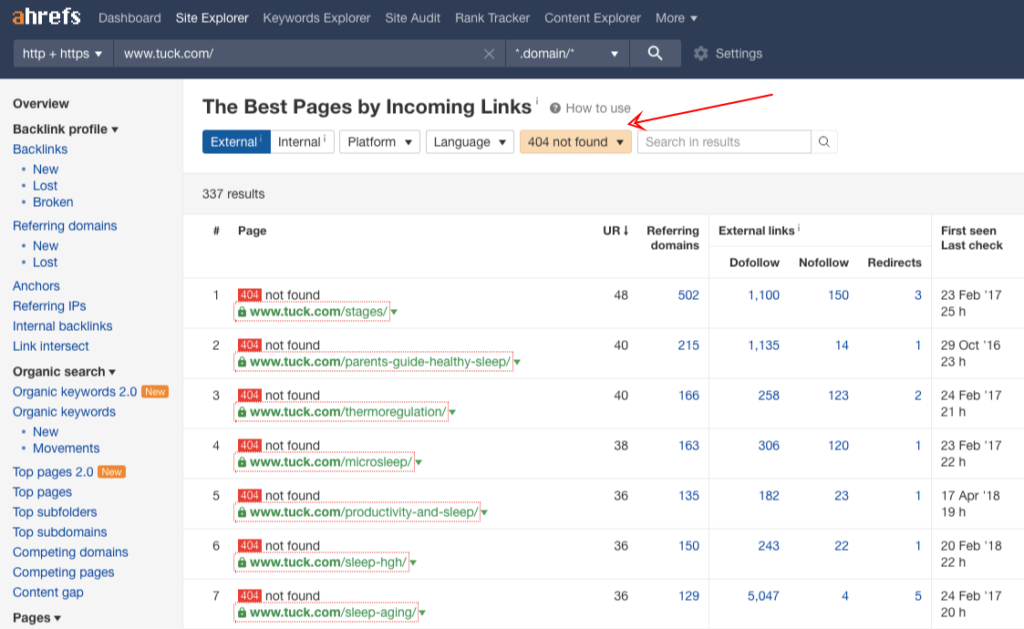

Here are some tips for you:
- Create similar content. If there is a broken linkable content, you can also create a version of it. You can click on the drop-down button and click “view on Archive.org to see its latest version.
- Get all pages linking to a linkable page. Click on the drop-down button again and click “Backlinks”. Now, you’ll see all pages linking to the linkable page.
- Once you create similar content, reach out to all of the linking pages and ask them to link to your newly published piece.
- Do step 1 through step 3 to all of the top linkable content of your competitor.
Find your unearned links from competitors.
You may have to find all of the top linkers of your competitors, and even their linkable content, another strategy to steal your competitors’ backlinks is to find your unearned links.
What are these unearned links?
These are backlinks you’ve never earned for whatever reasons, such as you haven’t reached out to them yet or they haven’t seen your content as a good reference.
How to find your unearned links from competitors?
You use Ahrefs Link Intersect tool.
Get all your competitors’ domains
Insert them into Link Intersect one by one.
Then click on “all intersections”, either check only two or three targets, whichever you prefer. If you choose 3, it only shows you websites that linked to at least three of your competitors.
To get more results, I prefer to just choose two targets.
Now, you have a list of all these websites linking to your competitors.
Inverted Broken Link Building SEO Strategy
How to acquire hundreds of links by banking on a “dead page”
Table of Contents
If you have never heard broken link building before, it’s basically a strategy wherein the steps are:
Step 1: Create a resource page for a linkable audience.
Linkable audiences could be students, parents, or job seekers.
Step 2: Find resource pages on the topic of your choice.
So if you have a resource guide for students, “How to Sleep Better for Students”, you wanna look for resource pages that can link to that page, either the page covers any “as a student tips or hacks.”
Step 3: Look for broken links on a page.
And see if there are links pointing to those broken links or pages.
Step 4: Get those existing links to broken pages.
And consider them as your backlink prospects.
Step 5: Reach out to the website owners.
Or people managing those broken pages and suggest your resource guide as a replacement to their broken links.
These five steps are what you normally do when you execute a typical broken link building strategy.
But let me show you a more effective way to do this - and this may be an advanced technique but it works pretty well if you want to maximize your efforts, time, and energy.
So here are the five steps.
How to Do Inverted Broken Link Building (SEO) Strategy
Step 1: Find broken pages you can recreate.
If a broken page has tons of links, you know for sure that you will get links. You actually find proof first before you invest in creating content. So many times, people would start with creating the content without really thinking if the topic of the content or the content itself has the potential to earn links as they promote it.
You can use Ahrefs’ Content Explorer to find content in your industry with backlinks to it.
Filter these pages by their http status, so you can only find 404 or broken pages.
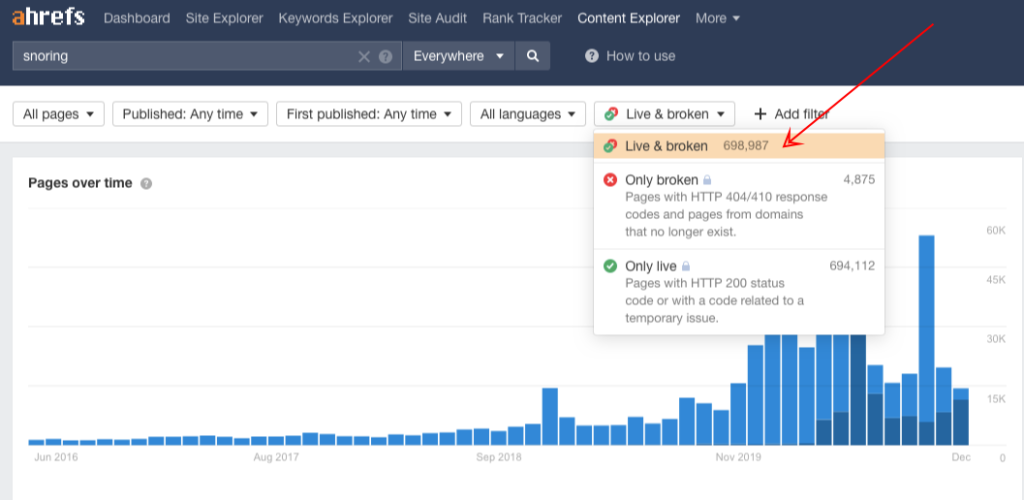

That leads us to step two, which is:
Step 2: Check the page’s linking domains.
Again, you want to make sure that the page that you want to recreate has proof of links. So go check it out using Link Explorer, again using Ahrefs, and see how man referring domains are linking to that broken page.
Step 3: Check the page’s original version using Wayback Machine.
You can use archive.org for this one.
So when you plugin the page into Wayback machine, you’ll then see its different versions. What you want to look at is its latest version (maybe broken at the moment you’re checking it, but the latest version when it was still live).
Now, you have the assurance that the topic or content you’ll be creating has the potential to get backlinks, the next thing to do is to create an improved version of that broken page.
Step 4: Create an improved version of the broken page.
So go again and check the old version of the page and see how you can recreate it in such a way that the information is more updated, with more graphics and videos if you can add those things. Just make sure that the new page is a more comprehensive one than its old broken version.
The last is to reach out to the linkers of the old page. Given that you know there are existing links to the broken page, what you can just do now is to list them down in a spreadsheet.
So send them outreach emails suggesting your new content as a replacement to the broken link on their page.
How to Use Where to Buy Pages for eCommerce Link Building
The eCommerce strategy to build backlinks to money pages without paying bloggers.
It’s actually one of the overlooked strategies when building links to online stores...and this is targeting where to buy pages.
Where to buy pages are basically pages where people search for places to find products or services. It includes lists of retailers, suppliers, affiliate partners, or anyone who distributes products you’re selling.
In different industries, there are where to buy pages that you can find. In the health industry, we have examples like “where to buy” diabetes care products.
In the transportation space, there are where to find transport options page, where people could just check the page and see what are the available options for traveling to and from the place.
You can also be as local-specific here like there are transport options page Adelaide (if you’re in Australia).
In the music industry, there are middle school and college websites that have vendors list pages. They have pages dedicated to sharing vendors of musical instruments with links pointing to each of their websites.
What you want to do is to check these link opportunities -- where to buy pages in your industry.
So start with knowing your current and potential partners.
Who are your manufacturers? Who are your retailers? Who are your distributors? Make an inventory of these people, these brands. You also want to check if they have their own websites, and if they have “where to buy” pages on their sites.
To see that, you can use advanced search operator, site colon:domain of the site. space, where to buy, For example, site:onlineshop.com “ where to buy.
You can also add more to your list by first checking your product categories. If you own a music online store, you have product categories like violin, viola, double bass.
Then check on Google to see if there are where to buy pages for those product categories.
Find where to buy opportunities with product categories, so you can do a Google search for “PRODUCT CATEGORY” inurl:links
For example, “classical instruments” inurl:links.
You may also go as specific to your product, and not just product category.
So here are some keywords you can use for that specific purpose.
- where to buy INDUSTRY OR PRODUCT
- online retailers INDUSTRY OR PRODUCT
- online dealers INDUSTRY OR PRODUCT
- find our products INDUSTRY OR PRODUCT
- additional retailers INDUSTRY OR PRODUCT
- internet resellers INDUSTRY OR PRODUCT
- preferred retailers INDUSTRY OR PRODUCT
Vary it on your partner type and your industry.
Once you have the list, go and ready to reach out to them and let them know that you distribute one of their products (if you’re a retailer or distributor) or get them to include a link to your product or product category page (if it’s a resource page).
How to Get Quality Backlinks With This HR Strategy
There is one thing that HR people do every day that can help you generate high-quality backlinks.
And that is using job boards to hire people.
You won’t do the hiring here. But you will use HR assets online to be able to get backlinks to your website.
Here is how you can start.
Find job boards list in your local city
There are resource pages that list down all of the available job sites and job boards within a local city or area.
For instance, there is a job board list page for anyone looking for work in Massachusetts. On that list, you’ll see different career websites and specific job board links from brands looking for hires.
This link building strategy is mostly applicable to startups, particularly tech companies.
There are a lot of job boards list pages that you can find online. Here are some keywords that you can use to find them:
- “Job search” “resources” “CITY”
- employment” inurl:resources “CITY”
- “job hunting” resources “CITY”
- inurl:careers “CITY”
Let’s say you have a job board list on your site. What you can do now is offer your job board as an additional resource to prospected resource pages.
When you do outreach, simply make a suggestion for your resource page. You’re not coming off as someone pushing them to link to you. Making a quick suggestion is a more effective strategy than pushing these people to link to you.
Hitting Your Number of Acquired Links Per Month
Setting a goal for every campaign is a critical success factor.
Without goal setting, you'll find yourself losing resources without hitting your target objectives at the end of the campaign.
In link building, most SEOs would like to hit a certain number of acquired links per month.
Is it a numbers game or are there other factors we have to consider?
In this blog post, let's discuss these considerations and dive into what really matters.
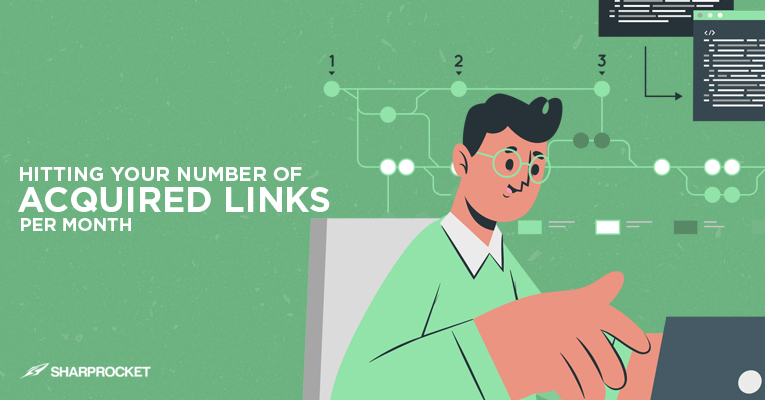

Table of Contents
Let's face reality. If you're dealing with clients for their link building projects, they often have a target number of links to hit every month.
This isn’t because it's just a numbers game, but because they've analyzed enough their backlink profile against their competitors. This is where marketers, SEOs, and link builders should start.
There are two ways to do this.
The first is to analyze your own backlink profile specifically its link velocity. Compare your growth month over month, or year over year.
You should have seen good consistent growth in terms of unique referring domains — these means people are attracted to your site and are linking to your pages both organically and manually (manually — you building links through link request or content promotion outreach).
If your site is new, you shouldn't expect much growth in terms of links. But if you've properly published linkable content assets, you should assume the momentum of links over time.
The second analysis that you can do is to look at your competitors' profiles. These are competitors competing with you on products/services you're also providing (and not competing for just content piece or page).
How many links are they getting passively each month? Ahrefs gives you a lot of insights into this.
Using the analysis of your site/client and its competitors, you should have a good sense of how many links you should be building and their range of authorities depending on the niche you're in.
Factors To Consider For Number of Acquired Links Per Month
Brand Requirements
If you're working on an enterprise link building campaign, head of SEOs or SEO managers have their own target number of links to acquire each month.
It could be based on their own analysis and decision making.
These types of websites with solid content teams have dedicated content hubs on their site ready to be promoted to its intended audience.
That being said, you may be working for just one content piece or set of content assets. This setup provides easy insights as to the supposedly hit link numbers.
Simply look at its content competitors (primarily competing pages on search results for its main/target keywords).
Using Ahrefs' Link Explorer, you can quickly see the number of referring links each page received.


From that, you can set a good range of target links to acquire each month.
Take note that you have to consider factors such as the competitors' brand authority, its post publishing existence (if they're the first one who covers the topic - they're likely to get initial benefits of trust and visibility), plus all other factors competitors have an advantage when they created their content assets.
Scope of Target Industries
Your target industries will play an important factor to the number of target links you want to acquire each month.
The more expandable you can be with your target audiences, the more number of links you can tap.
However, it depends on what kinds of links you want. If you're aiming for resource pages links, your target links depend on your intended linkable audiences. You can check out these two guides on resource pages and broken link building.
The bigger the scope of your audience targeting, the higher the number of acquired links you can target.
This doesn't mean you have to expand your target audiences because this will sometimes detach you from your brand's customer base.
Always check if it's feasible to expand your target audiences.
Linking Velocities of Competitors
Search marketing is a serious competition.
If the competition thrives at increasing the quantity and quality of links every month, it would be best to cope up with their speed and velocity.
You don't sacrifice quality here, but rather find ways to increase the types of links that matter to your site.
You can use Ahrefs to see your competitors' link velocity status.
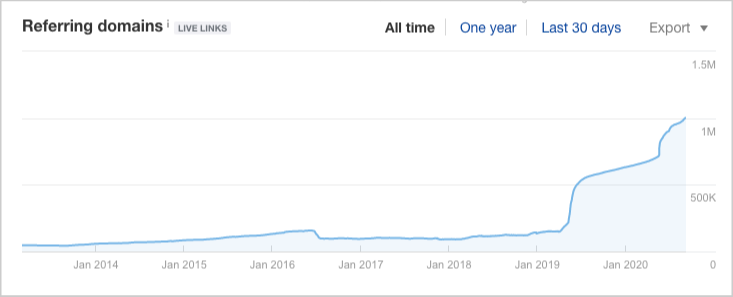
Prospecting Lists
The larger your prospect lists, the more likely you'll get more links in your link development campaign.
You should also account for other factors such as the effectiveness of outreach pitches, response times of prospects, seasonality of campaigns, and all connected factors to link results.
That being said, when you increase your prospecting lists while at the same factor in good efforts to other contributing success factors of the campaign, you can expect a higher number of acquired links per month.
Find flexibility for websites you can reach out to. Are there any other industries or types of linkers you can tap with for content promotion?
Expand your link search capabilities.
You can use tools like Citation Labs Link Prospector to semi-automate link prospecting.
Actionable Tips to Increase the Number of Acquired Links Per Month
Uncovering Passive Link Opportunities
Link acquisition can work passively. By investing effort in the promotion of solid content assets for initial links, those pages become more visible to other linkers either through dominating the search results for its target keywords and/or getting radar on mentions in targeted publications.
Find any old evergreen content assets that are underpromoted, yet have acquired a significant number of high-quality links in the past.
Make it more comprehensive than its previous version by adding more latest data, new content formats to suffice other learnings styles (such as videos, images, infographics, etc..).
You can check out these resources on creating link assets in boring niches and link building for SaaS template pages.
Use Ahrefs' Top Pages and sort by Best Links to find your site's top linkable assets.
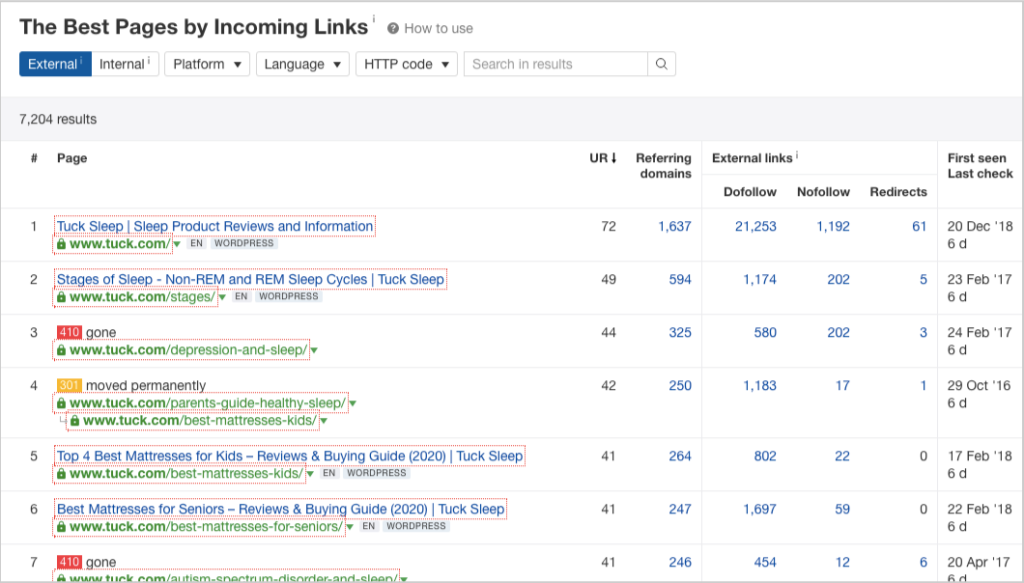

By doing so, you're not only relying on your manual link building outreach, but you're also consistently gaining new passive links that are relevant to your brand.
Invest in organic link generation to get ahead with your monthly target links.
You can check out this latest podcast by Siegemedia on generating passive links.
Links as a Leading Indicator of Success
For SEOs and agencies, the lagging indicators are search traffic and rankings.
Links become just a by-product of pushing efforts to hit those lag measures. Links, for them, is a leading indicator.
This is an important mindset to hit your number of acquired links each month. You may opt for the number of links but later on not be able to achieve your lagging indicators.
If you're building content assets from a search traffic improvement perspective, you get high-quality links along the process.
Factors and Processes
By knowing what matters most to your link building campaign and leveraging on processes — both major and menial initiatives – you're likely to hit your number of acquired links per month.
Link Building Approaches For New Campaigns
Someone handed you over a website to start a link building campaign. Unsure of what to do, you do a Google search for how to start link building.
A bunch of articles pop up and give you tips. Almost all of which say the same topic.
Different approaches. Different link building strategies. Now the question, where will you start?
In today's article, I'll share with you tips on what to do when a client comes if you're working for an agency, or when you've just decided to build links for your new business site.
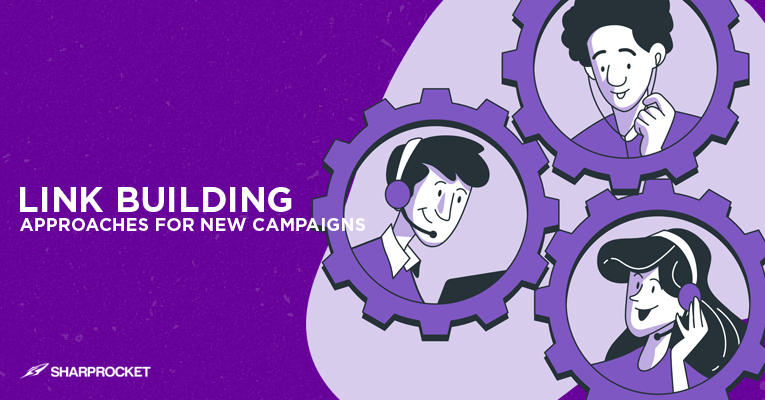
Table of Contents
Understanding Resource Allocation and Scope of Work
Link building is a piece of the pie in the entire business project. It isn't a compartmentalized business activity.
Instead, it requires that you also look at other parts of SEO — technical side, for example, to gauge whether the client's site is ready for some link building engagements.
Essentially, you don't want to jump right in to link acquisition without the technical set up properly. It's not a rule, but it helps you see more results and developments from your link building, if your foundation is solid.
What is your scope of work?
Entering into a new link building campaign, you have to know the extent of your work. Are you just working to build links to specific pages or you can get links to different pages of the site?
This is true for big brands that have solid content assets and are now hiring link builders or agencies to come up with efforts for content promotion.
The scope of work for most enterprise link building campaigns are geared towards specific pages they're looking to rank for or have had positive secondary efforts on their conversions (mostly top of the funnel or middle-of-the-funnel driving pages).
If you have a very targeted link building campaign (either for 1 big content asset), you have the advantage of gaining and allocating your resources effectively.
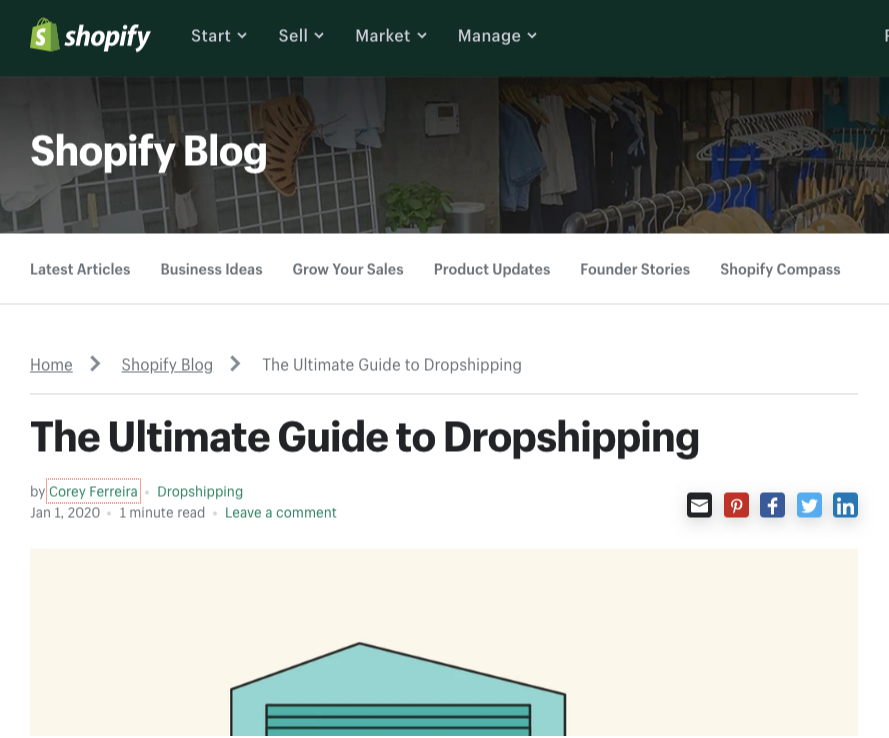
One-time off project or long-term campaign?
As an agency that provides link building services to SEO agencies, we get clients looking for a one-time off project. It's understandable they've had a tight budget, but it is more advantageous that they take a long-term mindset in link development.
Don't just take my word, see how Ross Hudgens point this out.
What are your available resources?
Link building requires a team. If you think you can be a solo link builder for life, you can, but it would consume more resources than you'd have otherwise expected.
Depending on the size of your brand and your allocated marketing budget for search, you must have a good rundown of your resources. This includes your manpower — content writers, web designers/developers, outreach specialists/link prospectors — all are working together to attract and manually build links to pages.
If you're a link building agency, you'd want to know if the brand has partnered up with other link dev agencies. You would want to get an idea of the types of links they're focusing on and their targeted pages for links.
Starting with Content Inventory
When approaching a new link building campaign, it is vital to have a good content audit.
Not all new link building campaigns mean that there isn't any content piece created in the past. It would have been a new project for you, but there are certain solid content pieces that have been published before.
Content audit of the site
So start looking for underpromoted content assets on your website, but has the potential to earn and gain new inbound links today. You can use Ahrefs to find pages that have gained a considerable amount of links (a few .edu links here and there), yet wasn't pushed enough for more acquisition.
Reverse engineer competitors' content
Knowing how your competitors generate content ideas and do outreach campaigns (even in this new normal season) can give you insights to forge your link development campaigns.
One, in particular, you have to look at is if they've gotten high-level domain links such as.edu links.
Using any link analysis tools like Ahrefs, you can quickly check if they've launched a specific program that attracts middle schooler pages or local colleges to link to them naturally.
The type of content and its unique value proposition matters how they've performed well in link acquisition.
Another insight to look at is the ability of the brand to get recurring links from the same domains. In Ahrefs, there is an option to filter and see domains with its different pages linking to the brand.
The discovery shows the perceivable value of the site or a specific content — turning it into a link bait authority site.
Discovering Targeted Link Building Tactics
New campaigns will unpack link building tactics suited for the brand, given its industry, available resources, and past histories of link dev campaigns.
This makes link building fun and exciting, as you'll have to strategize a customized campaign for the website.
We've mentioned earlier deciphering the link strategies of competitors by looking at how they've gotten links in the past.
Another thing you have to consider is the range of domain level/authority of sites linking to them.
For example, in a tight niche, your competitors may only be getting links from DA10 to DA40 sites. Does that mean they're low-level link builders? Of course not, the industry may only have a few niche blogs to reach out, but getting links from these content creators are likely to impact the site's performance — given the topical relevance of those linking domains.
Having a good grasp of authority levels of linking websites will help you set a benchmark of domain levels for your new link building campaign.
idiosyncrasies of Tactics
When embarking on a new link dev campaign, here are certain unusual activities associated with common link building tactics we know of today.
A few examples are:
- Finding unlinked mentions when the brand is not a common word (unlinked brand mentions)
- Using branded email addresses for broken link building outreach (broken link building)
Elements that are only identified once you start a new campaign must be well documented to be able to turn them into a written process. This gives you the advantage of scaling small activities that could have a significant impact on your link building performance.
Suitable Content-driven Tips
When you have the bandwidth to try and test new content-driven techniques for your new campaign, don't hesitate to do so.
For example, you can launch a data-driven campaign to attract any national or international press — debunking the myth that only big brands can execute this.
With an artistic approach to creation, adding visual graphic designs, and research-backed content combined with highly custom pitching to publishers, you can get initial results other older established competitors can be hard to replicate.
Focus On What Matters
You can be quick to implementing results right off the bat. It's good to implement some processes you've managed to document for your past link building campaigns. But it is still better to customize campaigns for specific industries based on their context, objectives, and resources.
Knowing what truly matters for the brand helps in launching your new link building campaign.







